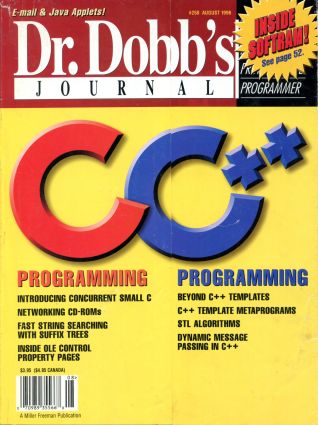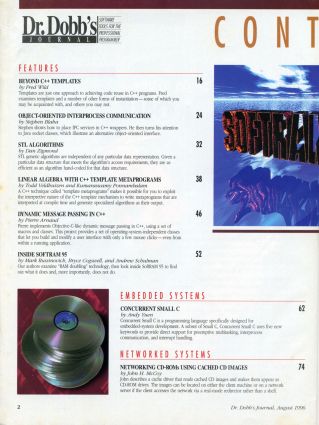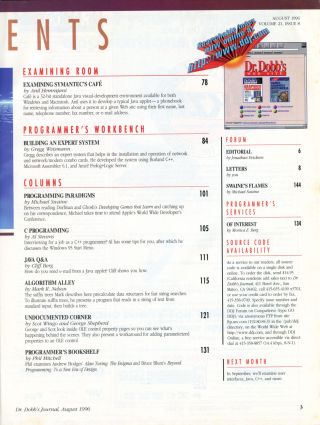
p.6 EDITORIAL
[author : Jonathan Erickson] #Edito
TABLE OF CONTENTS
FEATURES
p.16 BEYOND C++ TEMPLATES
[author : Fred Wild]
Templates are just one approach to achieving code reuse in C++ programs. Fred examines templates and a number of other forms of instantiation some of which you may be acquainted with, and others you may not.
p.24 OBJECT-ORIENTED INTERPROCESS COMMUNICATION
[author : Stephen Blaha]
Stephen shows how to place IPC services in C++ wrappers. He then turns his attention to Java socket classes, which illustrate an alternative object oriented interface.
p.32 STL ALGORITHMS
[author : Dan Zigmond]
STL generic algorithms are independent of any particular data representation. Given a particular data structure that meets the algorithm's access requirements, they are as efficient as an algorithm hand-coded for that data structure.
p.38 LINEAR ALGEBRA WITH C++ TEMPLATE METAPROGRAMS
[author : Todd Veldhuizen and Kumaraswamy Ponnambalam]
A C++ technique called "template metaprograms" makes it possible for you to exploit the interpretive nature of the C++ template mechanism to write metaprograms that are interpreted at compile time and generate specialized algorithms as their output.
p.46 DYNAMIC MESSAGE PASSING IN C++
[author : Pierre Arnaud]
Pierre implements Objective-C-like dynamic message passing in C++, using a set of macros and classes. This project provides a set of operating-system-independent classes that let you build and modify a user interface with only a few mouse clickseven from within a running application.
p.52 INSIDE SOFTRAM 95
[author : Mark Russinovich, Bryce Cogswell, and Andrew Schulman]
Our authors examine "RAM doubling" technology, then look inside SoftRAM 95 to find out what it does and, more importantly, does not do.
EMBEDDED SYSTEMS
p.62 CONCURRENT SMALL C
Andy Yuen
NETWORKED SYSTEMS
p.74 NETWORKING CD-ROMs USING CACHED CD IMAGES
[author : John H. McCoy]
John describes a cache driver that reads cached CD images and makes them appear as CD-ROM drives. The images can be located on either the client machine or on a network server if the client accesses the network via a real-mode redirector rather than a shell.
EXAMINING ROOM
p.78 EXAMINING SYMANTEC'S CAFE
[author : Anil Hemrajani]
Cafe is a 32-bit standalone Java visual-development environment available for both Windows and Macintosh. Anil uses it to develop a typical Java appleta phonebook for retrieving information about a person at a given Web site using their first name, last name, telephone number, fax number, or e-mail address.
PROGRAMMER'S WORKBENCH
p.84 BUILDING AN EXPERT SYSTEM
[author : Gregg Weismann]
Gregg describes an expert system that helps in the installation and operation of network and network/modem combo cards. He developed the system using Borland C++, Microsoft Assembler 6.1, and Amzi! Prolog+Logic Server.
COLUMNS
p.101 PROGRAMMING PARADIGMS
[author : Michael Swaine]
Between reading Dorfman and Ghosh's Developing Games that Learn and catching up on his correspondence, Michael takes time to attend Apple's World Wide Developer's Conference.
p.105 C PROGRAMMING
[author : Al Stevens]
Interviewing for a job as a C++ programmer? Al has some tips for you, after which he discusses the Windows 95 Start Menu.
p.111 JAVA Q&A
[author : Cliff Berg]
How do you send e-mail from a Java applet? Cliff shows you how.
p.115 ALGORITHM ALLEY
[author : Mark R. Nelson]
The suffix trees Mark describes here precalculate data structures for fast string searches. To illustrate suffix trees, he presents a program that reads in a string of text from standard input, then builds a tree.
p.121 UNDOCUMENTED CORNER
[author : Scot Wingo and George Shepherd]
George and Scot look inside OLE control property pages so you can see what's happening behind the scenes. They also present a workaround for adding parameterized properties to an OLE control.
p.131 PROGRAMMER'S BOOKSHELF
[author : Phil Mitchell]
Phil examines Andrew Hodges' Alan Turing: The Enigma and Bruce Blum's Beyond Programming: To a New Era of Design.
FORUM
p.8 LETTERS
[author : you]
p.144 SWAINE'S FLAMES
[author : Michael Swaine]
PROGRAMMER'S SERVICES
p.134 OF INTEREST
[author : Monica E. Berg]

